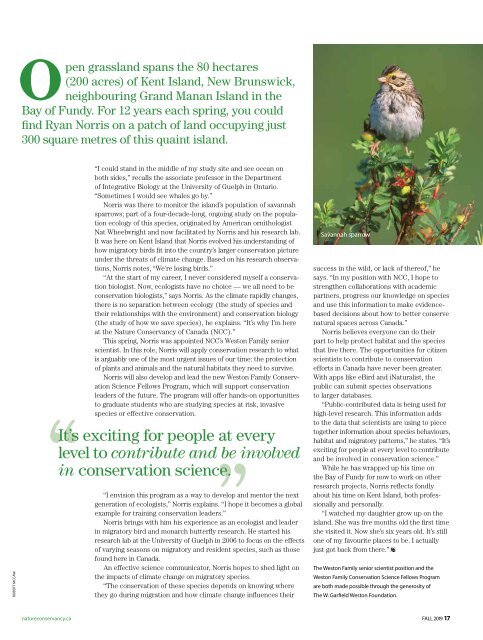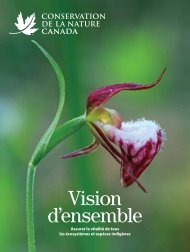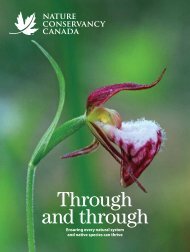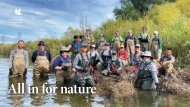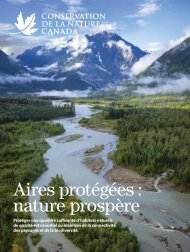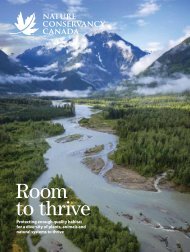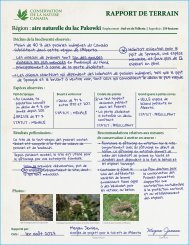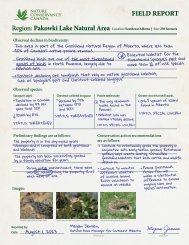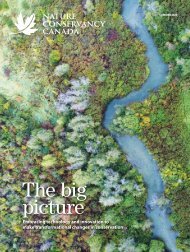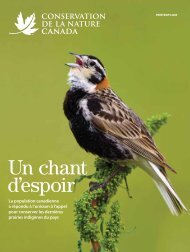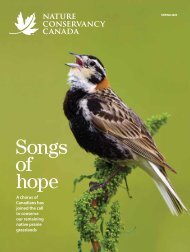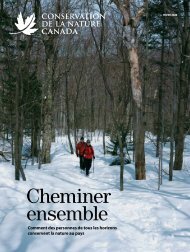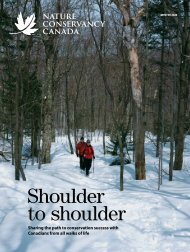NCC Magazine: Fall 2019
Create successful ePaper yourself
Turn your PDF publications into a flip-book with our unique Google optimized e-Paper software.
Open grassland spans the 80 hectares<br />
(200 acres) of Kent Island, New Brunswick,<br />
neighbouring Grand Manan Island in the<br />
Bay of Fundy. For 12 years each spring, you could<br />
find Ryan Norris on a patch of land occupying just<br />
300 square metres of this quaint island.<br />
ROBERT MCCAW.<br />
“I could stand in the middle of my study site and see ocean on<br />
both sides,” recalls the associate professor in the Department<br />
of Integrative Biology at the University of Guelph in Ontario.<br />
“Sometimes I would see whales go by.”<br />
Norris was there to monitor the island’s population of savannah<br />
sparrows; part of a four-decade-long, ongoing study on the population<br />
ecology of this species, originated by American ornithologist<br />
Nat Wheelwright and now facilitated by Norris and his research lab.<br />
It was here on Kent Island that Norris evolved his understanding of<br />
how migratory birds fit into the country’s larger conservation picture<br />
under the threats of climate change. Based on his research observations,<br />
Norris notes, “We’re losing birds.”<br />
“At the start of my career, I never considered myself a conservation<br />
biologist. Now, ecologists have no choice — we all need to be<br />
conservation biologists,” says Norris. As the climate rapidly changes,<br />
there is no separation between ecology (the study of species and<br />
their relationships with the environment) and conservation biology<br />
(the study of how we save species), he explains. “It’s why I’m here<br />
at the Nature Conservancy of Canada (<strong>NCC</strong>).”<br />
This spring, Norris was appointed <strong>NCC</strong>’s Weston Family senior<br />
scientist. In this role, Norris will apply conservation research to what<br />
is arguably one of the most urgent issues of our time: the protection<br />
of plants and animals and the natural habitats they need to survive.<br />
Norris will also develop and lead the new Weston Family Conservation<br />
Science Fellows Program, which will support conservation<br />
leaders of the future. The program will offer hands-on opportunities<br />
to graduate students who are studying species at risk, invasive<br />
species or effective conservation.<br />
It’s exciting for people at every<br />
level to contribute and be involved<br />
in conservation science.<br />
“I envision this program as a way to develop and mentor the next<br />
generation of ecologists,” Norris explains. “I hope it becomes a global<br />
example for training conservation leaders.”<br />
Norris brings with him his experience as an ecologist and leader<br />
in migratory bird and monarch butterfly research. He started his<br />
research lab at the University of Guelph in 2006 to focus on the effects<br />
of varying seasons on migratory and resident species, such as those<br />
found here in Canada.<br />
An effective science communicator, Norris hopes to shed light on<br />
the impacts of climate change on migratory species.<br />
“The conservation of these species depends on knowing where<br />
they go during migration and how climate change influences their<br />
Savannah sparrow<br />
success in the wild, or lack of thereof,” he<br />
says. “In my position with <strong>NCC</strong>, I hope to<br />
strengthen collaborations with academic<br />
partners, progress our knowledge on species<br />
and use this information to make evidencebased<br />
decisions about how to better conserve<br />
natural spaces across Canada.”<br />
Norris believes everyone can do their<br />
part to help protect habitat and the species<br />
that live there. The opportunities for citizen<br />
scientists to contribute to conservation<br />
efforts in Canada have never been greater.<br />
With apps like eBird and iNaturalist, the<br />
public can submit species observations<br />
to larger databases.<br />
“Public-contributed data is being used for<br />
high-level research. This information adds<br />
to the data that scientists are using to piece<br />
together information about species behaviours,<br />
habitat and migratory patterns,” he states. “It’s<br />
exciting for people at every level to contribute<br />
and be involved in conservation science.”<br />
While he has wrapped up his time on<br />
the Bay of Fundy for now to work on other<br />
research projects, Norris reflects fondly<br />
about his time on Kent Island, both professionally<br />
and personally.<br />
“I watched my daughter grow up on the<br />
island. She was five months old the first time<br />
she visited it. Now she’s six years old. It’s still<br />
one of my favourite places to be. I actually<br />
just got back from there.”1<br />
The Weston Family senior scientist position and the<br />
Weston Family Conservation Science Fellows Program<br />
are both made possible through the generosity of<br />
The W. Garfield Weston Foundation.<br />
natureconservancy.ca<br />
FALL <strong>2019</strong> 17


